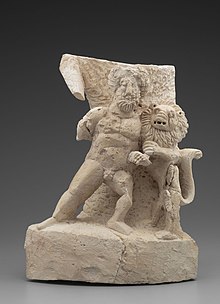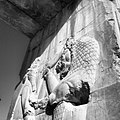Statue of Heracles from Dura Europos

The statue of Heracles, Yale Art Gallery 1938.5302 was found in Dura Europos in the temple of Zeus Megistos during joint excavations 1935–1937 by Yale University and the French Academy. The statue is made of limestone and is about 50 cm high, 40 wide and 30 cm deep. The demigod is shown frontally, strangling a lion with his left arm. The right arm, the left knee, parts of the lion's body and the lion's paws have broken away. Anatomical details of the body are usually only indicated by incised lines. The legs appear too fat compared to the rest of the body. The modeling is rather schematic; the feet are flat. The genitals are damaged, but the pubic hair is cut into the stone with many details. While the head and torso are shown frontally, the legs are shown from the side. The shape of the base suggests that the sculpture once stood in a corner. This is confirmed by the remains of stucco on the back of the work. The statue is dated to the time when Dura Europos was under Roman rule, i.e. around the years AD 160 to 256.
The statue shows Heracles with the Nemean lion . Heracles' images were relatively popular in Dura Europos. Around 42 examples have come to light during the excavations in the city, five of which show the demigod with the Nemean lion. The popularity of this motif may go back to oriental ideas of a hero defeating a lion. The motif has a long tradition in oriental art. There are images from the third millennium BC that show Gilgamesh fighting a lion. A well-known example are depictions from Persepolis that show a man fighting a lion.
The statue, along with some other statues and reliefs, may have come from a workshop in Dura Europos, which also includes several other Heracles statues, which have similar features and are all made of white limestone. Other sculptures from Dura Europos follow in style and style works from Palmyra and are on average of better quality, while the works of this workshop mostly appear clumsy and clumsy. The frontality of the statue is typical of Parthian art.
The work is owned by the Yale University Art Gallery .
Man defeats lions. Relief from Persepolis
Individual evidence
- ↑ Jennifer A. Baird: Dura-Europos , Bloomsbury Academic, London 2018, ISBN 978-1-4725-2211-5 , p. 14.
- ↑ Downey: The Heracles Sculpure , pp. 29-30
- ↑ Downey: The Heracles Sculpure , pp. 44-45
- ↑ Downey: The Heracles Sculpure , p 71
- ↑ Lucinda Dirven: Strangers and Sojouners: the Religious Behavior of Palmyrenes and other Foreigners in Dura-Europos , in: Lisa R. Brody, Gail L. Hoffman (eds.): Dura Europos, Crossroads of Antiquity. , Pp. 201–220, here: 210
literature
- Susan B. Downey: The Heracles Sculpure (The Excavations at Dura-Europos: Final Report III, Part I, Fascicle 1), New Haven 1969, pp. 29-30. No. 31. Plate XII
- Lisa R. Brody, Gail L. Hoffman (Eds.): Dura Europos, Crossroads of Antiquity. Boston 2011, ISBN 978-1-892850-16-4 , p. 354, no.47


